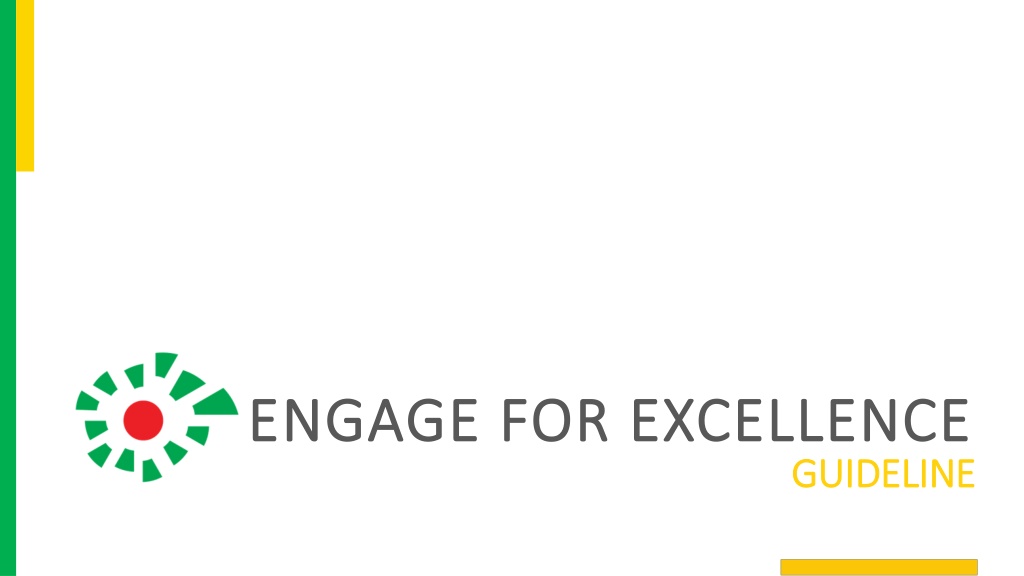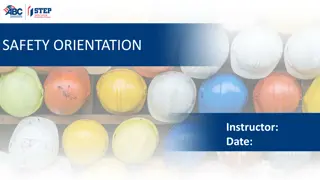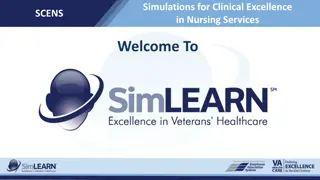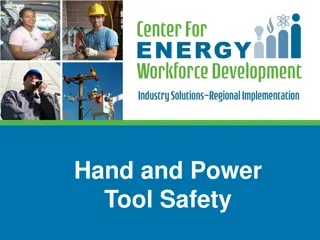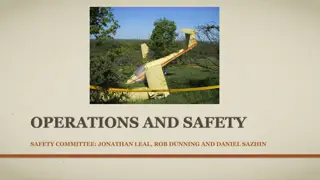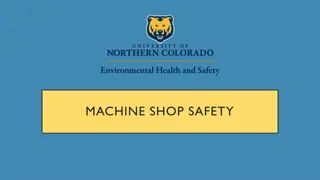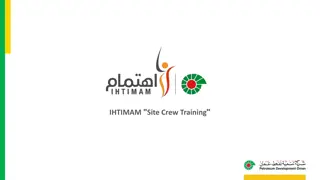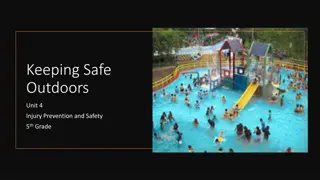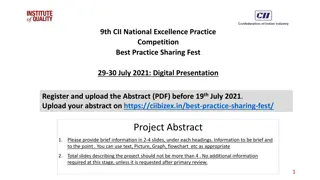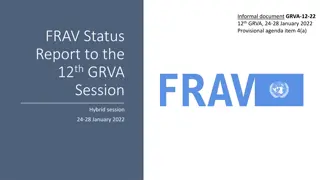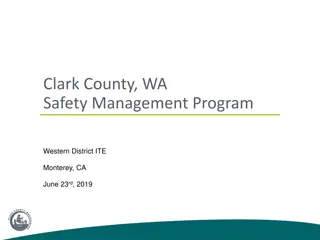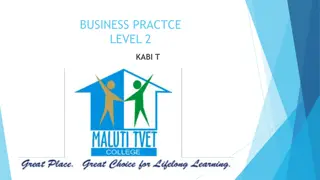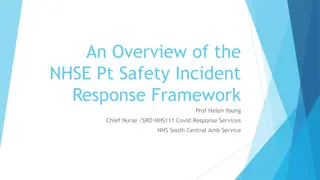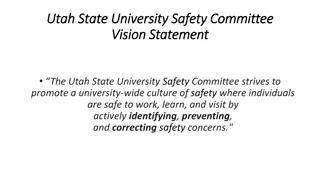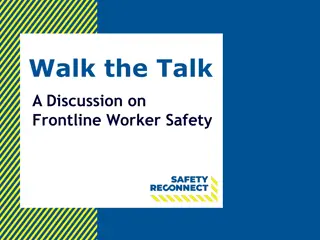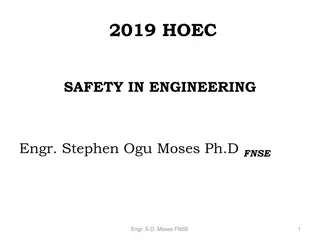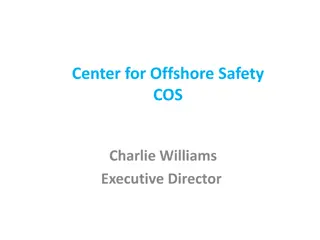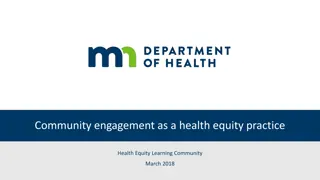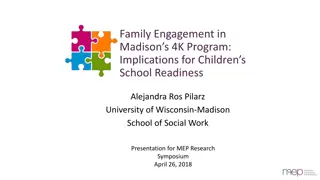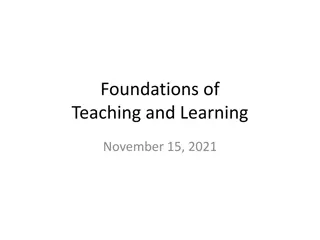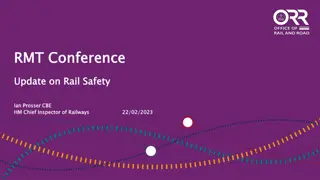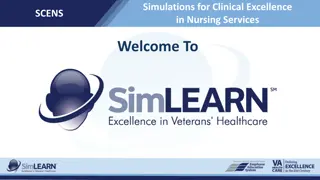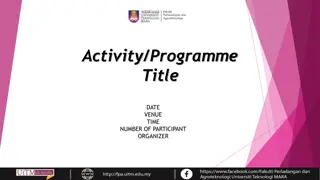Comprehensive Engagement Guidelines for Excellence in Safety Practices
Detailed guidelines are provided for engaging stakeholders at various levels to ensure safety excellence. The guidelines emphasize reflection, dialogue, action planning, and continuous improvement to address safety concerns effectively. Tools and templates are included to support the implementation and monitoring of safety engagement initiatives.
Download Presentation

Please find below an Image/Link to download the presentation.
The content on the website is provided AS IS for your information and personal use only. It may not be sold, licensed, or shared on other websites without obtaining consent from the author. Download presentation by click this link. If you encounter any issues during the download, it is possible that the publisher has removed the file from their server.
E N D
Presentation Transcript
ENGAGE FOR EXCELLENCE ENGAGE FOR EXCELLENCE GUIDELINE GUIDELINE
ENGAGEMENT GUIDELINE ENGAGEMENT GUIDELINE # Action Comments & References 1 MDC members to present pack to their management team and respective contractor CEO s. Reflections should be captured and documented. Way forward to continue the engagement down the hierarchy should be discussed. Director should appoint a focal to receive weekly progress updates. Director to be included in engagements where possible. Engagements should not solely be delivered by HSE personal, the engagement is to encourage line involvement and accountability. Pack will be shared with all MDC members after initial engagement. It is also included here: Link Reflections capture tool: Link 2 Respectivedirectorate management to deliver engagement to their teams. Reflections should be captured and documented. Expectations from management on how to deliver the engagement down the hierarchy should be communicated. Focal points should be selected to begin the logistical work of scheduling engagements, site visits, monitoring and assurance. PDO should work alongside contractors to deliver the engagements to the frontline and capture reflections. Each directorate should select who is best suited to deliver the engagement to the frontline. Engagements should be done face to face as feasible to the frontline. Online engagements should be kept to small groups of no more than 30-50 in order to capture reflections from the majority. Engagement progress update template: Link 3 Deliver engagements to all respective staff and frontline workers. Capture reflections Conduct analysis of reflections and findings Develop action plans Update progress report weekly Discuss findings during weekly/bi-weekly meetings (bottom up approach) CEO s to update directors weekly Directors to update MD weekly. The engagement and discussions should prompt in depth conversations around safety concerns, immediate issues to be addressed, identify gaps, and take a continuous improvement approach to improving safety.
ENGAGEMENT SUPPORT ENGAGEMENT SUPPORT # Tools Comments & References 1 Content pack is provided and accessible to contractors and PDO staff on the provided link. Content pack can be modified slightly to address safety concerns management would like to highlight, however these concerns should encourage reflections and not indicate blame. LTI s provided in the content pack can also be modified should the respective directorate or contractor wish to reflect solely on incidents that occurred in their areas, however we do not encourage this, to allow opportunity to learn and prevent other incidents from happening. Content pack: Link LTI Template: Link 2 Reflection capture tool is available on the provided link, all directorate and contractor focal points should upload their captured statements on the tool to allow for easy data collection and analysis. A guideline for using the tool is also provided in the link. Each directorate to provide names and reference indicator to (MSE53) for admin access. Reflections capture tool: Link 3 A template to monitor progress of engagement and safety performance is available in the link provided. Should you wish to add additional data to the template you may, however what is provided in the template is the standard minimum. The template provided should be made available to MD & MSEM either by an online link, or by sending an email copy. Engagement progress update template: Link
MEASURING PROGRESS MEASURING PROGRESS # Measure Leading or Lagging Relevance 1 IHTIMAM/STOP/BBS observations Leading An increase in observations and interventions, gives us the opportunity to learn where our risks are, any changes we need to make, and serve as an opportunity for learning and depicting a potential incident. 2 Total number of near miss s reported Category of near miss Number of near misses verified in system Number of correct near misses reported Number of incidents & observations reported in NM tool. Leading Near misses are an opportunity to rectify or apply a barrier, before an incident where harm to an individual or asset may occur. Do our NM s relate to our observations? Do they relate to our incidents? Did we miss an opportunity to prevent an incident? Is our community aware of how and where to correctly report a NM, Observation, incident? Do they have enough awareness? Do we verify NM s on time to maximize opportunity for learning? 3 Number of sites engagement completed, against total number. Lagging To monitor progress of sites that have been engaged and those pending. Should a site that has been engaged have an incident, go back to see if something was missed in the reflections that was not actioned. 4 Number of reflections received Thematic/categories of reflections Systemic/behavioral/procedural findings Actions implemented Leadings Understanding where our issues are Prioritize systemic and procedural concerns, this will address behaviors. Develop an action plan to mitigate risks. 5 Feed back to frontline Leading Informing staff and frontline of findings, progress and actions Consulting them for feedback on changes
OTHER AREAS FOR CONSIDERATION OTHER AREAS FOR CONSIDERATION # Measure Leading or Lagging Relevance 1 Linking feedback and suggested corrective actions to previous incidents Leading This indicates that issues have not been resolved through the actions generated by the incident investigation, or were not implemented effectively. 2 Same suggested measures from incidents, audits, observations and feedback. (LFI) Leading If we are receiving the same suggestions from audits, observations, feedback from staff and frontline and other means, then it is an indicator we aren t listening and not taking quick enough action to mitigate risks. 3 Safety meetings & information management. (Consistent meetings with visible leadership) Leading How effective are our engagements? How often do we receive feedback from the line? How much telling vs. listening? How quick do we make decisions/implement actions? How much focus is given to leading indicators vs. lagging indicators? How does continuous improvement support our HSE performance?
AWARENESS ON AWARENESS ON EMPLOYEE ENGAGEMENT ENGAGEMENT EMPLOYEE
Employee engagement can be defined as the extend to which employees feel passionate about their jobs, are committed to the organization, and put discretionary effort into their work. Employee engagement is not the same as employee satisfaction, Employee satisfaction only indicates how happy or content your employees are. It does not address their level of motivation, involvement, or emotional commitment. For some employees, being satisfied means collecting a paycheck while doing as little work as possible. Employee Engagement When organizations focus on how to improve employee satisfaction, changes won t necessarily lead to increased performance. Oftentimes, the conditions that make employees satisfied with their jobs are the same conditions that frustrate high performing employees. Top performers embrace change, search out ways to improve, and challenge the status quo. They expect all employees be held accountable for delivering results, whereas low performers avoid accountability, cling to the status quo, and resist change.
Employee engagement goes beyond activities, games, and events. Employee engagement drives performance. Engaged employees look at the whole of the company and understand their purpose, where, and how they fit in. This leads to better decision-making. Why is Employee Engagement Important? Organizations with an engaged workforce outperform their competition. Engagement is a key differentiator when it comes to growth and innovation.
Studies suggest that companies with good safety performance and safety culture keep employees engaged and emotionally devoted to the organization and its goals. Disengaged employees often do not report minor injuries, hazards or near misses. They check out during safety briefings and show a general lack of interest for the safety program -- often breaking rules and taking advantage of shortcuts. Engaged workers are fully committed to their work and the success of the company. They put in more effort, have a higher quality work product, go out of their way to assist others, have fewer accidents and are willing to provide feedback and suggestions on ways to increase efficiencies and improve the work environment. How Does Engagement Improve Safety Performance?
What does employee engagement look and feel like from an employee perspective? Employee engagement is about understanding one s role in an organization and being energized on where it fits in the organization s purpose and objectives. Employee engagement is about having a clear understanding of how an organization is fulfilling its purpose and objectives, how it is changing to fulfil those better, and giving employees a voice in its journey to offer ideas and express views that are taken account of as decisions are made. Employee engagement is about including employees fully as a member of the team, focusing on clear goals, giving trust and empowerment, receiving regular and constructive feedback, supported in developing new skills, and thanked and recognized for achievement. Engaged organizations have strong and authentic values, with clear evidence of trust and fairness based on mutual respect, where two-way promises and commitments between management and employees are understood and fulfilled.
What does employee engagement look like and feel like from a leadership perspective? Employee engagement is about influencing positive attitudes and behaviors leading to improved business outcomes, in a way that they trigger and reinforce one another. Employee engagement is about making your employees feel pride and loyalty working for PDO, being a great advocate to our clients, users and customers, going the extra mile to finish a piece of work. Employee engagement is about drawing on our employees knowledge and ideas to improve our products and services and be innovative about how we work. Employee engagement is about drawing out a deeper commitment from our employees, so fewer leave, sick absence reduces, accident rates decline, conflicts and grievances go down, productivity increases. Employee engagement is about ensuring our actions are consistent with PDO s values. It is about kept promises, or an explanation why they cannot be kept.
Involve employees in the safety program Involve employees in the safety program In weekly or monthly safety meetings, openly discuss all changes, before they are implemented. Let their voices be heard Let their voices be heard allow staff members to voice their opinions, concerns and ideas without fear of reprimand. Always ensure good lines of communication Always ensure good lines of communication Be approachable and keep your door open . Offer positive feedback Offer positive feedback Mistakes don t always need to be punished. Stay positive and remember that implementation is a process. Respect employees and their ideas Respect employees and their ideas Not every idea is good or constructive, but showing that you re willing to consider them is a great way to instill confidence. What can we do differently from today to engage our employees and contractors on safety and performance?
Recognize great work Recognize great work When an employee goes above and beyond what is asked of them, make sure they are recognized for the effort. Set clear guidelines Set clear guidelines Employees must know what they re striving for, and displaying/discussing safety parameters helps provide that clarity. Continue their education Continue their education Proper safety tactics can t be regulated to a one and done meeting. It s better to hold ongoing sessions to keep skills sharp. Instill a sense of ownership Instill a sense of ownership Let employees know their worth and show that you trust them to do the job right, every time. Maintain your compassion Maintain your compassion If someone is injured or has a scare, show that you care about their well-being, rather than diving directly into corrective measures. What can we do differently from today to engage our employees and contractors on safety and performance?
Give credit where its due Give credit where it s due If an employee reports a near-miss, provides an idea that is later implemented or continues to look out for the safety of others, reward them for their efforts. Be concise always Be concise always If you re asked a question regarding safety procedures, be straightforward with your response. Do not linger in any grey areas. Provide the necessary tools Provide the necessary tools Ensure your team has the tools they need to do the job safely and replace those that may hinder such efforts. Reinforce positive behaviors Reinforce positive behaviors Put in place a system of formal, informal and on-the-spot recognition that can help show the company s appreciation for hard work. Be respectful Be respectful Speak to your employees as equals and let them know you think of them as such. People are more inclined to pay attention, if they re not being talked down to. What can we do differently from today to engage our employees and contractors on safety and performance?
Remember Once properly implemented, these tips have the potential to become the turning point needed to build a safer, more engaged workplace. Just remember that these actions cannot be forced upon a team. Allow them to take hold naturally and invite your staff to offer feedback and opinions as things progress. The more engaged you allow your employees to become, the better the results you ll see from all engagement and safety efforts.
